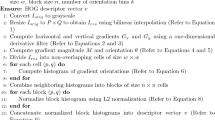Abstract
An explicit formula of a multivariate B-spline, some useful investigations in the field of linear transformations of independent exponentially distributed random variables, representation of theirs density functions with the help of multivariate exponential spline functions, and their usage are considered. The consideration is illustrated by an appropriate example.
Similar content being viewed by others
References
D. Hubel, Eye, Brain, and Vision [Russian translation], Mir, Moscow (1990).
Z. L. Rabinovich and G. S. Voronkov, “Knowledge representation and processing in interacting sensory and language neurosystems,” Cybernetics and Systems Analysis, 34, No. 2, 251–267 (1998).
L. I. Timchenko, “A multistage parallel-hierarchic network as a model of a neurolike computation scheme,” Cybernetics and Systems Analysis, 36, No. 2, 251–267 (2000).
J. E. Hinton, “How neural networks are trained,” Scientific American [Russian translation], Nos. 11–12, 103–110 (1992).
L. I. Timchenko, “Convergent and divergent processes in natural and artificial neural networks,” Visnyk VPI, No. 1, 5–10 (1997).
S. V. Svechnikov, V. P. Kozhemyako, and L. I. Timchenko, Quasimpulse-Potential Optoelectronic Elements and Devices of Logical-Temporal Type [in Russian], Naukova Dumka, Kiev (1987).
L. I. Timchenko, Yu. F. Kutaev, V. P. Kozhemyako, et al., “Nafez Shweiki method for training of a parallelhierarchical network, Based on Population Coding for Processing of Extended Laser Paths Images,” in: Proc. SPIE, 4790 (2002), pp. 465–479.
A. L. Zheleznyak, L. I. Timchenko, O. I. Stasyuk, et al., Segmentation of Half-Tone Pictures with Respect to Connectedness [in Ukrainian], DETUT, Kyiv (2008).
N. G. Basov, E. M. Zemskov, Yu. F. Kutaev, et al., “Laser control of near earth space and possibilities for removal of space debris from orbit with explosive photo-dissociation lasers with phase conjugation,” in: Proc. GCL/HPL 98, SPIE Symposium, St.-Petersburg (1998).
L. I. Timchenko, Yu. F. Kutaev, O. A. Gertsiy, N. O. Shweiki, and Yu. V. Baibak, “A networking system for nonstationary signals,” Izv. RAN, Ser. Fiz., No. 6, 886–890 (2001).
M. O. Kovzel, L. I. Timchenko, Yu. F. Kutaev, et al., Parallel-Hierarchical Transformation and Q-Processing of Information for Real-Time Systems [in Ukrainian], KUETT, Kyiv (2006).
L. I. Timchenko, S. V. Chepornyuk, Yu. F. Kutaev, and O. A. Gertsiy, “Compact image model description for image classification,” Visnyk VPI, No. 2, 72–83 (1998).
V. P. Kozhemyako, Yu. F. Kutaev, S. V. Svechnikov, L. I. Timchenko, and A. A. Yarovyi, Parallel–Hierarchical Transformation as a System Model of Optical-Electronic Means of Artificial Intelligence [in Ukrainian], UNIVERSUM–Vinnytsya, Vinnytsya (2003).
M. A. Grudin, D. M. Harvey, L. I. Timchenko, and P. J. G. Lisboa, “Face recognition method using a multistage hierarchical network,” in: Proc. IEEE Int. Conf. on Acoust., Speech, and Signal Proc. ICASSP97, 4, Munich, Germany (1997), pp. 2545–2548.
V. P. Kozhemyako, Y. F. Kutaev, L. I. Timchenko, et al., “The Q-transformation method applying to the facial images normalization,” in: Proc. International ICSC IFAC Symposium on NEURAL COMPUTATION–NC’98, Vienna (1998).
A. Lanitis, C. J. Taylor, and T. F. Cootes, “Automatic face identification system using flexible appearance models,” Image and Vision Computing,” 13, No. 5, 393–401 (1995).
J. K. Aggarwal, “Object recognition and performance bounds,” in: Proc. Conf. on Image Analysis and Processing, Florence, Italy (1997), pp. 343–360.
V. P. Kozhemyako, L. I. Timchenko, and A. A. Yarovyi, Parallel–Hierarchical Networks as the Structural-Functional Basis for the Construction of Specialized Pattern Computer Models [in Ukrainian], UNIVERSUM–Vinnytsya, Vinnytsya (2005).
L. I. Timchenko, Y. F. Kutaev, S. V. Chepornyuk, et al., “A brain-like approach to multistage hierarchical image,” in: Proc. Conf. on Image Analysis and Processing (Florence, Italy), Springer (1997), pp. 246–253.
D. O. Hebb, The Organization of Behavior: A Neuropsychological Theory, Wiley, Oxford, England (1949).
L. I. Timchenko, V. P. Kozhemyako, Y. F. Kutaev, et al., “Method for processing of extended laser paths images,” in: Advances in Electrical and Computer Engineering, 3(10), No. 2 (20), Stefan cel Mare University of Suceava, Suceava, Romania (2003), pp. 66–78.
V. P. Kozhemyako, L. I. Timchenko, Yu. F. Kutaev, and I. D. Ivasyuk, Introduction to the Algorithmic Theory of Hierarchy and Parallelism of Neural-Like Computational Environments and Its Application to Image Transformation: Fundamentals of the Theory of Pyramidal Network Transformation of Patterns [in Ukrainian], UMK VO, Kyiv (1994).
W. K. Pratt, Digital Image Processing [Russian translation], Mir, Moscow (1982).
Author information
Authors and Affiliations
Corresponding author
Additional information
Translated from Kibernetika i Sistemnyi Analiz, No. 1, pp. 152–163, January–February 2011.
Rights and permissions
About this article
Cite this article
Timchenko, L.I., Melnikov, V.V., Kokryatskaya, N.I. et al. A method of organization of a parallel-hierarchical network for image recognition. Cybern Syst Anal 47, 140–151 (2011). https://doi.org/10.1007/s10559-011-9297-3
Received:
Published:
Issue Date:
DOI: https://doi.org/10.1007/s10559-011-9297-3




